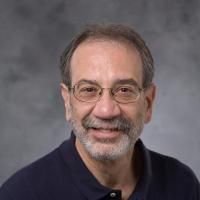The role of chemotherapy in the treatment of central neurocytoma.
Date
2019-11-05
Journal Title
Journal ISSN
Volume Title
Repository Usage Stats
views
downloads
Citation Stats
Abstract
Aim: Central neurocytoma (CN) is a rare WHO grade II central nervous system (CNS) tumor. This is an update on chemotherapeutic agents used in its treatment. Patients & methods: An institutional review board-approved, chart review of patients seen at our institution resulted in a single case treated with chemotherapy and is herein included. We proceeded with a comprehensive literature review. Results: We identified 18 citations, representing 39 cases of adult and pediatric CN treated with chemotherapy. With the addition of our single case, the total number of recurrent CN patients treated with temozolomide (TMZ) is nine. Conclusion: There exists marked heterogeneity in chemotherapy used to treat CN. TMZ is incorporated into treatment regimens in the setting of tumor recurrence: its role merits further study.
Type
Department
Description
Provenance
Subjects
Citation
Permalink
Published Version (Please cite this version)
Publication Info
Johnson, Margaret O, John P Kirkpatrick, Mallika P Patel, Annick Desjardins, Dina M Randazzo, Henry S Friedman, David M Ashley, Katherine B Peters, et al. (2019). The role of chemotherapy in the treatment of central neurocytoma. CNS oncology, 8(3). p. CNS41. 10.2217/cns-2019-0012 Retrieved from https://hdl.handle.net/10161/21349.
This is constructed from limited available data and may be imprecise. To cite this article, please review & use the official citation provided by the journal.
Collections
Scholars@Duke

Margaret Johnson
I am a neuro-oncologist, neurologist, and palliative care physician at the Preston Robert Tisch Brain Tumor Center. I also provide neuro-oncology expertise for the National Tele-Oncology Program and National Precision Oncology Program at the Veteran's Health Administration. My clinical and research interests encompass supportive care and palliative care with a special interest in older adults with brain tumors. The incidence of malignant brain tumors like glioblastoma and non-malignant tumors like meningioma affect aging populations and it is crucial to be able to provide better care for these patients.

John P. Kirkpatrick
Malignant and benign tumors of the brain, spine and base of skull. Mathematical modelling of tumor metabolism, mass transfer and the response to ionizing radiation. Enhancing clinical outcome in stereotactic radiosurgery, fractionated stereotactic radiotherapy and stereotactic body radiotherapy.

Annick Desjardins

Henry Seth Friedman
Overview: Our laboratory is pursuing a comprehensive analysis of the biology and therapy of adult and childhood central nervous system malignancies, particularly high-grade medulloblastoma, glioma, and ependymoma.
Laboratory Studies: Active programs, using human adult and pediatric CNS tumor continuous cell lines, transplantable xenografts growing subcutaneously and intracranially in athymic nude mice and rats, and as well as in the subarachnoid space of the athymic nude rats, and patients tumor specimens, are defining:
1) the chemotherapeutic profile of medulloblastoma, adult and childhood glioma and ependymoma
2) mechanisms of resistance to classical bifunctional alkylators, nitrosoureas and methylators operational in malignant glioma and medulloblastoma, particularly DNA adduct and crosslink repair, O6-alkylguanine-DNA alkyltransferase elevation and DNA mismatch repair deficiency.
3) modulations designed to over come or circumvent specific mechanisms of resistance
4) the activity of signal pathway inhibitors of EGFR, m-tor and other targets
5) the therapeutic advantages of intrathecal and intratumoral drug delivery in the treatment of neoplastic meningitis and intracranial malignancies, respectively.
The results of the therapeutic studies to date have demonstrated the marked activity of alkylating agents, particularly melphalan and cyclophosphamide and the role of glutathione, AGT glutathione-S-transferase, abnormal drug transport and alterations in formation and repair of DNA-DNA crosslinks in modulating cytotoxicity of these agents. Modulations shown to be effective in enhancing alkylator activity/reversing alkylator resistance include BSO-mediated glutathione depletion, inhibition of DNA-DNA crosslink repair and inhibition of 06-alkylguanine-DNA alkyltransferase by 06-benzylguanine. Recent studies have demonstrated profound activity of temozolomide, CPT-11 topotecan, irofulven, and karenitecin as well as the combination of CPT-11 or topotecan plus BCNU or temozolomide. Successful treatment of neoplastic meningitis in nude rats with intrathecal 4-hydroperoxycyclophosphamide, melphalan, temozolomide and busulfan, and intracranial glioma in nude rats with intratumoral temozolomide has also been demonstrated. More recent studies have revealed cyclophosphamide resistance secondary to DNA interstrand crosslink repair. Additional studies have shown that cyclophosphamide crosslinks are formed at the 1,3 N7 position, serving as the basis for construction of a defined crosslink in a plasmid vector to assay for crosslink repair and allowing demonstration of the lack of a role of nucleotide excision repair. Mismatch repair deficiency has been shown as a mechanism mediating acquired methylator (procarbazine and temozolomide) resistance in an adult glioblastoma xenograft.
Clinical Studies: Clinical investigations are designed to translate laboratory programs into successful treatment for adults and children with malignant brain tumors, particularly medulloblastoma. Clinical trials for adults include phase II trials of temozolomide, ZD1839 (Iressa), karenitecin, and temozolomide plus O6-BG as well as phase I trials of topotecan plus BCNU, CPT-11 plus temozolomide, and PTK787 ± temozolomide or CCNU. Studies are in progress in children evaluating the activity CPT-11 plus temozolomide, intrathecal busulfan and cyclophosphamide/melphalan or cyclophosphamide/busulfan plus autologous bone marrow support . Extension of these studies to a larger cohort of patients is being performed nationally under the auspices of the Pediatric Brain Tumor Consortium (Henry S. Friedman -- Head of New Agents Committee).
Future studies will address the role of agents designed to decrease repair of interstrand crosslinks when given in combination with alkylating agents, as well as newer signal pathway inhibitors such as RAD001, PKI166, and DB-67.

David Michael Ashley
My career in cancer research dates more than two decades. I am credentialed in both pediatric and adult neuro-oncology practice and this has been the focus of my efforts in translational research and leadership. As evident from my publication and grant support record, my primary academic focus has been on neurologic tumors, the development of innovative therapies and approaches to care. These efforts have included basic and translational laboratory research. My experience includes moving laboratory findings in brain tumor immunology and epigenetics into early phase clinical trials. I have expertise in immuno-oncology, having developed and clinically tested dendritic cell vaccines and other immuno-therapeutics. My achievements in research have led to change in practice in the care of children and adults with brain tumors, including the introduction of new standards of practice for the delivery of systemic therapy. I am highly regarded for this work, as evidenced by numerous invitations to plenary sessions and symposia of international standing. I have been the principal investigator of a number of important national and international studies, both clinical and pre-clinical. I am recognized as a senior figure and opinion leader in neuro-oncology nationally and internationally. I have held several significant leadership roles, including Director of two major cancer centers, I served as the Chair of Medicine at Deakin University, the Program Director of Cancer Services at University Hospital Barwon Health, and Executive Director of the Western Alliance Academic Health Science Centre (Australia). I began my current position as Director of The Preston Robert Tisch Brain Tumor Center, Head, Preuss Laboratory, in March 2018. In this role, I am responsible for the clinical care, research, and educational program related to Brain Tumor Center. I am also a senior investigational neuro-oncologist within the adult brain tumor program at Duke.

Katherine Barnett Peters
Katy Peters, MD, PhD, FAAN is a professor of neurology and neurosurgery at the Preston Robert Tisch Brain Tumor Center (PRTBTC) at Duke. Her academic medical career started at Stanford University School of Medicine, receiving an MD and Ph.D. in Cancer Biology. After completing a neurology residency at Johns Hopkins University and a fellowship in cognitive neurosciences, Katy joined the PRTBTC as a neuro-oncology fellow. In 2009, she became a faculty member at PRTBTC. With a fantastic team of nursing and advanced practice providers, she actively sees and cares for patients with primary brain tumors. Her research interests include supportive care for brain cancer patients, cognitive dysfunction in cancer patients, and physical function and activity of brain cancer patients. While she runs clinical trials to treat primary brain tumors, her key interest is on clinical trials that focus on improving brain tumor patients' quality of life and cognition. In 2019, the PRTBTC designated her as the Director of Supportive Care, thus furthering the PRTBTC and her committee to better the quality of life for brain tumor patients. She is active in teaching medical school students, residents, fellows, and advanced practice providers and is the Program Director of the PRTBRC neuro-oncology fellowship. She is board certified by the American Board of Psychiatry and Neurology and the United Council of Neurologic Subspecialties for neuro-oncology.
Unless otherwise indicated, scholarly articles published by Duke faculty members are made available here with a CC-BY-NC (Creative Commons Attribution Non-Commercial) license, as enabled by the Duke Open Access Policy. If you wish to use the materials in ways not already permitted under CC-BY-NC, please consult the copyright owner. Other materials are made available here through the author’s grant of a non-exclusive license to make their work openly accessible.
